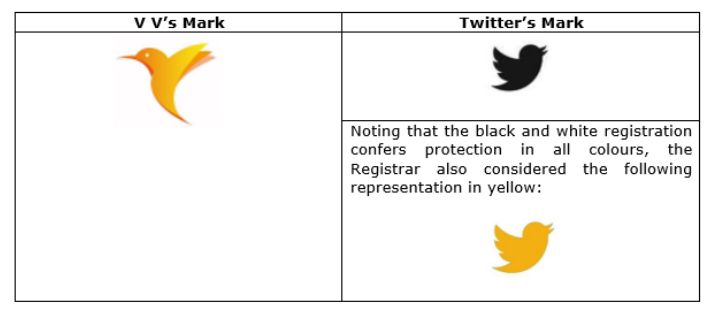The similarity of competing marks is assessed in Singapore (and in many other jurisdictions) from visual, aural and conceptual standpoints. But what if the marks are devices without any textual element? How does this influence the assessment?
We discuss the key takeaways from Twitter, Inc. v V V Technology Pte Ltd [2022] SGIPOS 4, an opposition centred around two bird device marks.

Visual similarity
The Registrar noted that shape, movement, features and composition can provide useful parameters for comparing device marks. He concluded that the marks were visually similar as both depict the profile of a small flying bird without detailed features. Ultimately, visual similarity is determined by the general impression evoked by dominant features of the marks.
Aural similarity
Twitter submitted that the marks are aurally identical as consumers would refer to both as "bird marks". The Registrar disagreed, stating that aural similarity is "of marginal relevance (if at all)" in relation to device marks, though there may be exceptions, given that device marks are typically used alongside or referred to by word marks. For example, consumers would say "McDonald's" instead of "golden arches" in relation to the device.
Conceptual similarity
Twitter submitted that both marks evoke the idea of a flying bird, which outweighs any visual or aural differences. The Registrar agreed that the marks are conceptually similar and this carries "more than marginal relevance" as the bird concept is non-descriptive. However, visual similarity played a greater role in the overall assessment.
Similarity in the services
The Registrar dismissed V V Technology's arguments on the different commercial uses of the parties' goods and services. He emphasised that the degree of similarity is determined by comparing the specifications under the respective marks, rather than how they are actually used or intended to be used. Applying this approach, he found that the goods and services (e.g. "monitoring of computer systems") directly overlapped.
Likelihood of confusion
In addition to the similarities in the marks and services, the surrounding circumstances also pointed toward a likelihood of confusion.
- Characteristics of average consumers: The Registrar acknowledged that "specialist consumers" may be more careful when making a purchase. However, the goods and services in this case, including mobile applications, are used by the general public who would pay a lower than average degree of attention.
- Nature of the goods and services: Mobile applications are available at low or no cost, and if an application is wrongly downloaded this can be easily remedied.
- Reputation: The reputation of Twitter's Mark reduces the risk of consumers mistaking Twitter's Mark for V V's Mark or vice versa. However, the Registrar held that there was likelihood of consumers mistaking V V's Mark for an extension or a new iteration of Twitter's Mark, noting that Twitter has used several iterations of a bird logo in the short period of time since incorporation:

Based on the above, the Registrar concluded that there was a likelihood of confusion and also that use of V V's Mark would amount to misrepresentation in the context of passing off. Accordingly, Twitter succeeded in the opposition.
Key Takeaways
A nuanced approach is required when assessing device marks. This is especially the case with simple stylisations, such as device marks used as icons for mobile applications and in user interfaces. This decision provides a useful bird's eye view of the applicable principles when dealing with such marks.
The content of this article is intended to provide a general guide to the subject matter. Specialist advice should be sought about your specific circumstances.


